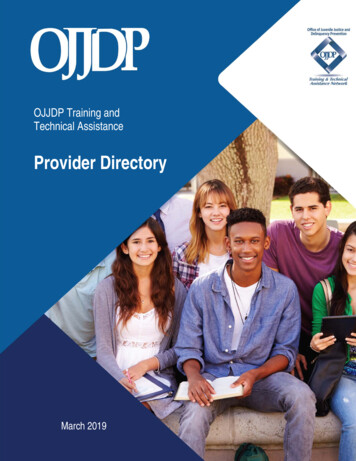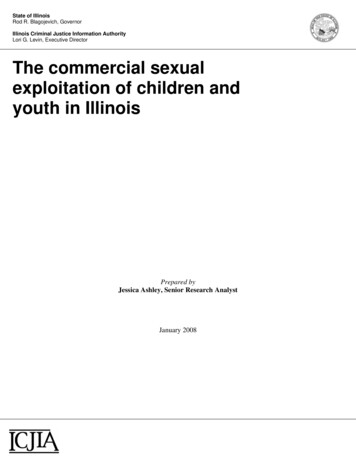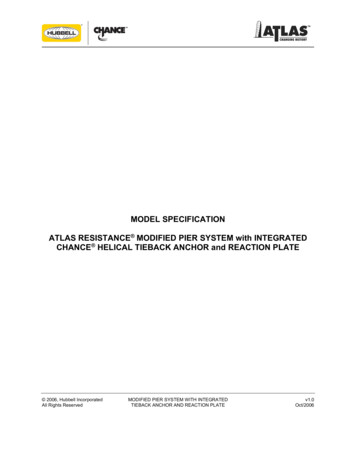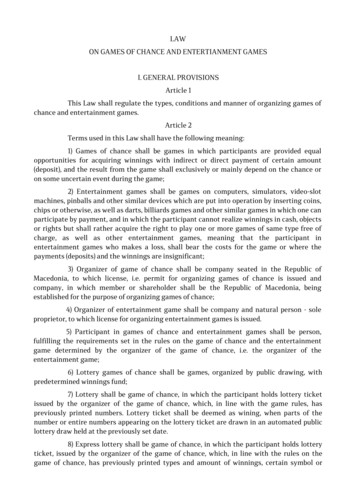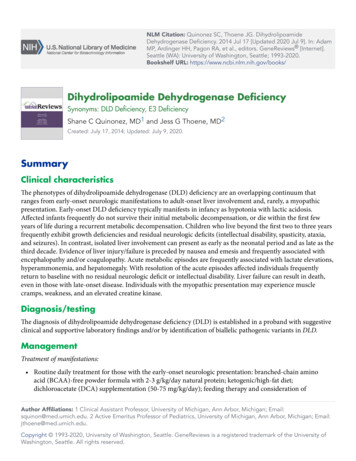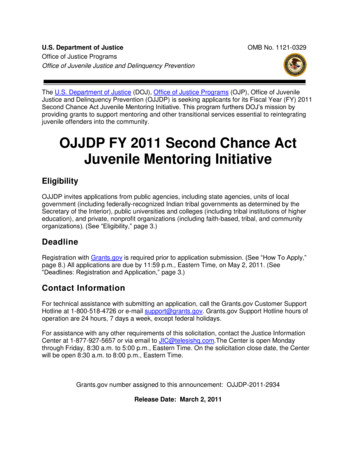
Transcription
U.S. Department of JusticeOffice of Justice ProgramsOffice of Juvenile Justice and Delinquency PreventionOMB No. 1121-0329The U.S. Department of Justice (DOJ), Office of Justice Programs (OJP), Office of JuvenileJustice and Delinquency Prevention (OJJDP) is seeking applicants for its Fiscal Year (FY) 2011Second Chance Act Juvenile Mentoring Initiative. This program furthers DOJ‟s mission byproviding grants to support mentoring and other transitional services essential to reintegratingjuvenile offenders into the community.OJJDP FY 2011 Second Chance ActJuvenile Mentoring InitiativeEligibilityOJJDP invites applications from public agencies, including state agencies, units of localgovernment (including federally-recognized Indian tribal governments as determined by theSecretary of the Interior), public universities and colleges (including tribal institutions of highereducation), and private, nonprofit organizations (including faith-based, tribal, and communityorganizations). (See “Eligibility,” page 3.)DeadlineRegistration with Grants.gov is required prior to application submission. (See “How To Apply,”page 8.) All applications are due by 11:59 p.m., Eastern Time, on May 2, 2011. (See“Deadlines: Registration and Application,” page 3.)Contact InformationFor technical assistance with submitting an application, call the Grants.gov Customer SupportHotline at 1-800-518-4726 or e-mail support@grants.gov. Grants.gov Support Hotline hours ofoperation are 24 hours, 7 days a week, except federal holidays.For assistance with any other requirements of this solicitation, contact the Justice InformationCenter at 1-877-927-5657 or via email to JIC@telesishq.com.The Center is open Mondaythrough Friday, 8:30 a.m. to 5:00 p.m., Eastern Time. On the solicitation close date, the Centerwill be open 8:30 a.m. to 8:00 p.m., Eastern Time.Grants.gov number assigned to this announcement: OJJDP-2011-2934Release Date: March 2, 2011
ContentsOverview . 3Deadlines: Registration and Application . 3Eligibility . 3Program-Specific Information . 3Performance Measures . 6Project Evaluations . 8Notice of New Post-Award Reporting Requirements . 8How To Apply . 8What an Application Is Expected To Include .10Standard Form-424 (SF-424) .10Program Narrative .11Budget Detail Worksheet and Budget Narrative .15Indirect Cost Rate Agreement (if appropriate) .15Tribal Authorizing Resolution (if appropriate).16Other Attachments .16Other Standard Forms.16Selection Criteria.17Review Process .17Additional Requirements .18Appendix: Application Checklist .192OMB No. 1121-0329Approval Expires 02/28/2013OJJDP FY 2011 Second Chance Act Juvenile Mentoring InitiativeOJJDP-2011-2934
OJJDP FY 2011 Second Chance ActJuvenile Mentoring Initiative(CFDA #16.812)OverviewThe Second Chance Act (P.L. 110-199) authorizes grants to government agencies and nonprofitgroups to provide employment assistance, substance abuse treatment, housing, familyprogramming, mentoring, victims‟ support, and other services to help adult and juvenile exoffenders to transition successfully from incarceration to the community. OJJDP will providegrants to support mentoring and other transitional services essential to reintegrating juvenileoffenders into their communities. Award recipients will use their grants to mentor juvenileoffenders during secure confinement, through transition back to the community, and postrelease; to provide transitional services to assist them in their reintegration into the community;and to support training in offender and victims‟ issues. This program will be authorized by an actappropriating funds for the Department of Justice.Deadlines: Registration and ApplicationRegistration with Grants.gov is required prior to application submission. OJJDP encouragesapplicants to register several weeks before the application deadline of 11:59 p.m., EasternTime, on May 2, 2011. See “How To Apply,” page 8, for details.EligibilityOJJDP invites applications from public agencies, including state agencies, units of localgovernment (including federally-recognized Indian tribal governments as determined by theSecretary of the Interior), public universities and colleges (including tribal institutions of highereducation), and private, nonprofit organizations (including faith-based, tribal, and communityorganizations).Joint applications from two or more eligible applicants are welcome; however, one applicantmust be clearly indicated as the primary applicant (for correspondence, award, andmanagement purposes) and the others indicated as co-applicants.Targeted youth must be admitted to the program prior to their 18th birthday. However, a reentryplan can continue to be implemented for these individuals beyond their 18th birthday. OJJDPdoes not have a set timeline for terminating these services, but instead they can continue aslong as is deemed therapeutically necessary.Program-Specific InformationMentoring is a structured and trusting relationship that brings young people together with caringindividuals who offer guidance, support, and encouragement aimed at developing theircompetence and character. Youth offenders are at high risk for recidivism and have the greatestneed for mentoring and other transitional support services. After release from secureconfinement, many young ex-offenders return to the environments that helped create their3OMB No. 1121-0329Approval Expires 02/28/2013OJJDP FY 2011 Second Chance Act Juvenile Mentoring InitiativeOJJDP-2011-2934
problems and do not have caring, mature adults to guide them through the challenges that theyface. OJJDP-supported research and evaluations indicate that mentoring relationships shouldbe structured to support a relationship that lasts at least 12 months or through an entire schoolyear. Research further finds that mentoring relationships that last 2 or more years significantlyincrease positive outcomes for youth. Since structured support is critical for the mentoringrelationship, best practices require significant contact between mentor and mentee and arelationship that perceives the mentor as a friend rather than simply an authoritative figure.OJJDP recommends that award recipients provide program services at least 6 months prior tothe juvenile mentee‟s release from secure confinement. Community mentoring partnershipsincrease the capacity of local communities to implement mentoring programs through innovativecross-system collaboration among state, local, and tribal governments and public and privatepartners (such as community and faith-based organizations).PurposeThe purpose of this initiative is to support the successful and safe transition of juvenile offendersfrom correctional facilities to their communities. To this end, OJJDP will provide funding todevelop, implement, and expand mentoring programs and transitional services. OJJDP expectssuccessful applicants to integrate best practices and proven principles into mentoring servicemodels, develop strategies to recruit and maintain mentors, and assess and develop services torespond to the needs of youth offenders reentering their communities. Local communitycollaboratives should lead such programs, design them to address local needs, and use localresources. If local resources are not available, the program should obtain resources outside ofthe community through partnerships and other collaborative efforts.Goals, Objectives, and DeliverablesThe initiative‟s goals are to reduce recidivism among juvenile ex-offenders, enhance safety incommunities, and enhance the capacity of local partnerships to address the needs of juvenileex-offenders returning to their communities.The initiative is designed to strengthen communities characterized by large numbers ofreturning juvenile offenders. Applicants should describe a process that will match mentoringpairs during the youth‟s confinement and lead to successful community reintegration, evidencedby a lack of recidivism. The process should include the delivery of a variety of evidence-basedprogram services while the youth is in confinement and after release. Applicants mustdemonstrate that they will use validated and dynamic assessment tools to determine the risksand needs of offenders in the project‟s target population.Evidence-based Programs or PracticesOJP considers programs and practices to be evidence-based when their effectiveness has beendemonstrated by causal evidence, generally obtained through outcome evaluations. Causalevidence documents a relationship between an activity or intervention (including technology)and its intended outcome, including measuring the direction and size of a change, and theextent to which a change may be attributed to the activity or intervention. Causal evidencedepends on the use of scientific methods to rule out, to the extent possible, alternativeexplanations for the documented change. The strength of causal evidence, based on the factorsdescribed above, will influence the degree to which OJP considers a program or practice to beevidence-based.4OMB No. 1121-0329Approval Expires 02/28/2013OJJDP FY 2011 Second Chance Act Juvenile Mentoring InitiativeOJJDP-2011-2934
For additional information on evidence-base programs, see OJJDP„s Model Programs Guide atwww.ojjdp.gov/mpg.Amount and Length of AwardsOJJDP will make awards of as much as 625,000 per award for a project period of as long as 3years. These will be one-time awards to cover the entire project period. A match is required withthis award. See below for further details.All awards are subject to the availability of appropriated funds and any modifications oradditional requirements that may be imposed by law.Budget InformationLimitation on Use of Award Funds for Employee Compensation; Waiver: With respect toany award of more than 250,000 made under this solicitation, federal funds may not be used topay total cash compensation (salary plus bonuses) to any employee of the award recipient at arate that exceeds 110% of the maximum annual salary payable to a member of the FederalGovernment‟s Senior Executive Service (SES) at an agency with a Certified SES PerformanceAppraisal System for that year. (The 2011 salary table for SES employees is available atwww.opm.gov/oca/11tables/indexSES.asp.) Note: A recipient may compensate an employee ata higher rate, provided the amount in excess of this compensation limitation is paid with nonfederal funds. (Any such additional compensation will not be considered matching funds wherematch requirements apply.)The limitation on compensation rates allowable under an award may be waived on an individualbasis at the discretion of the Assistant Attorney General for OJP. Applicants that wish to requesta waiver must include a detailed justification in the budget narrative of their applications. Unlessapplicants submit a waiver request and justification with their application, they should anticipatethat OJP will request that they adjust and resubmit their budget.The justification should include: the particular qualifications and expertise of the individual, theuniqueness of the service being provided, the individual‟s specific knowledge of the program orproject being undertaken with award funds, and a statement explaining that the individual‟ssalary is commensurate with the regular and customary rate for an individual with his/herqualifications and expertise, and for the work that is to be done.Match RequirementFederal funds awarded under this program may not cover more than 75 percent of the totalcosts of the project being funded. The applicant must identify the source of the 25 percentnonfederal portion of the total project costs and how they will use match funds. (Match isrestricted to the same uses of funds as allowed for the federal funds.) Applicants may satisfythis match requirement with either cash or in-kind services. The formula for calculating thematch is:Federal Award AmountFederal Share Percentage Adjusted (Total) Project CostsRequired Recipient‟s Share Percentage x Adjusted Project Cost Required Match5OMB No. 1121-0329Approval Expires 02/28/2013OJJDP FY 2011 Second Chance Act Juvenile Mentoring InitiativeOJJDP-2011-2934
Example: 75%/25% match requirement: for a federal award amount of 350,000, match wouldbe calculated as follows: 350,000 466,66775%25% x 466,667 116,667 matchPerformance MeasuresTo assist the Department in fulfilling its responsibilities under the Government Performance andResults Act (GPRA), Public Law 103-62, applicants that receive funding under this solicitationmust provide data that measure the results of their work. Any award recipient will be required,post award, to provide the data requested in the “Data Grantee Provides” column so that OJPcan calculate values for the “Performance Measures” column. Performance measures for thissolicitation are as follows:ObjectivesPerformance MeasuresEstablish/improveadministration ofmentoring programs for at- Percentage increase in numberrisk, underserved youth,of program mentors recruited.including expansion ofmentoring strategies andprogram design.Data Grantee ProvidesDuring the reporting period:Number of mentors atbeginning of program.Number of mentors at closeof reporting period.Number of mentors.Enhance/improve theorganizational capacity,system efficiency, andcost effectiveness ofmentoring programsthrough training/ technicalassistance and otherstrategies.Percentage of program mentorssuccessfully completingtraining.Number of trained programmentors.Number of mentorssuccessfully completingtraining.Percentage of trained programmentors with increasedknowledge of the program area.Number of trained mentorsdemonstrating increasedknowledge of the programarea.Program mentor retention rate.Number of mentors who leftthe program.Number grantees implementingan evidence-based program/practice,* as determined byOJJDP.Evidence-based programs/practices implemented bygrantee.Percentage increase in youthenrolled since the beginning ofthe program (grant period).Number of youth enrolled atthe beginning of theprogram.6OMB No. 1121-0329Approval Expires 02/28/2013OJJDP FY 2011 Second Chance Act Juvenile Mentoring InitiativeOJJDP-2011-2934
Improve outcomes for atrisk youth in mentoringprograms by establishingand strengtheningcollaborative communityapproaches.Percentage of mentoringprograms with active partners.Number of youth currentlyenrolled.Number of mentoringprograms.Number of mentoringprograms with activepartners, including nonprofitservice organizations, faithbased organizations, privateindustry, secondary andpost-secondary educationproviders, vocational trainingproviders, and other activepartners.Number of program youthserved.Number of youth carried overfrom the previous reportingperiod, plus new admissionsduring the current period.Percentage of program youthcompleting programrequirements.Number of youth who exitedthe program, successfullyand unsuccessfully.Number of youth who exitedthe program havingcompleted programrequirementsPercentage of program youthwho offend/reoffend.Number of youth with a newoffense.Percentage of program youthexhibiting desired change in thetargeted behavior, which willdepend on specific programgoals and activities and mayinclude academic achievement,school attendance, socialcompetence, etc.Number of youth exhibiting adesired change in targetedbehavior.Submission of performance measures data is not required for the application. Instead,applicants should discuss in their application their proposed methods for collecting data forperformance measures. Please refer to the section “What an Application Is Expected ToInclude” (below) for additional information.For more information about OJJDP performance measures, seewww.ojjdp.ncjrs.gov/grantees/pm/.7OMB No. 1121-0329Approval Expires 02/28/2013OJJDP FY 2011 Second Chance Act Juvenile Mentoring InitiativeOJJDP-2011-2934
Project EvaluationsApplicants that propose to use funds awarded through this solicitation to conduct projectevaluations should be aware that certain project evaluations (such as systematic investigationsto develop or contribute to generalizable knowledge) may constitute “research” for purposes ofapplicable DOJ human subjects protections. However, project evaluations that are intended togenerate internal improvements to a program or service or to meet OJP‟s performance measuredata reporting requirements likely do not constitute “research.” Applicants should providesufficient information for OJP to determine whether the particular project they propose wouldeither intentionally or unintentionally collect and/or use information in such a way that it meetsthe DOJ regulatory definition of research.Research, for the purposes of human subjects protections for OJP-funded programs, is definedas, “a systematic investigation, including research development, testing, and evaluation,designed to develop or contribute to generalizable knowledge.” 28 C.F.R. § 46.102(d). Foradditional information on determining whether a proposed activity would constitute research,see the decision tree on the “Research and the Protection of Human Subjects” section of theOJP “Other Requirements for OJP Applications” Web page(www.ojp.usdoj.gov/funding/other requirements.htm). Applicants whose proposals may involvea research or statistical component also should review the “Confidentiality” section on that Webpage.Notice of New Post-Award Reporting RequirementsApplicants should anticipate that all recipients (other than individuals) of awards of 25,000 ormore under this solicitation, consistent with the Federal Funding Accountability andTransparency Act of 2006 (FFATA), will be required to report award information on any first-tiersubawards totaling 25,000 or more, and, in certain cases, to report information on the namesand total compensation of the five most highly compensated executives of the recipient andfirst-tier subrecipients. Each applicant entity must ensure that it has the necessary processesand systems in place to comply with the reporting requirements should it receive funding.Reports regarding subawards will be made through the FFATA Subaward Reporting System,found at www.fsrs.gov.Applicants should anticipate that no subaward of an award made under this solicitation may bemade to a subrecipient (other than an individual) unless the potential subrecipient acquires andprovides a Data Universal Numbering System (DUNS) number.How To ApplyApplications should be submitted through Grants.gov. Complete instructions on how to registerand submit an application can be found at www.grants.gov. Applicants who experiencedifficulties during this process should call the Grants.gov Customer Support Hotline at 1-800518-4726. Hotline hours of operation are 24 hours, 7 days a week, except federal holidays.Registering with Grants.gov is a one-time process; however, processing delays may occur andit can take several weeks for first-time registrants to receive confirmation and a user password.OJJDP recommends that applicant register as early as possible to avoid delays in submittingtheir applications by the deadline.8OMB No. 1121-0329Approval Expires 02/28/2013OJJDP FY 2011 Second Chance Act Juvenile Mentoring InitiativeOJJDP-2011-2934
All applicants are required to complete the following steps:1. Acquire a DUNS number. A DUNS number is required to submit an application in GMS.OMB requires that all applicants for federal funds (other than individuals, who are exemptfrom this requirement) include a DUNS number in their applications for a new award orrenewal of an existing award. A DUNS number is a unique nine-digit sequence recognizedas the universal standard for identifying and tracking entities receiving federal funds. Theidentifier is used to validate address and point of contact information for federal assistanceapplicants, recipients, and subrecipients. The DUNS number will be used throughout thegrant life cycle. Obtaining a DUNS number is a free, one-time activity. Obtain a DUNSnumber by calling 1–866–705–5711 or by applying online at www.dnb.com.2. Acquire or Renew Registration with the Central Contractor Registration (CCR)Database. OJP requires that all applicants (other than individuals) for federal financialassistance maintain current registrations in the Central Contractor Registration (CCR)database. An applicant must be registered in the CCR to successfully register in Grants.gov.The CCR database is the repository for standard information about federal financialassistance applicants, recipients, and subrecipients. Organizations that have previouslysubmitted applications via Grants.gov are already registered with CCR. However, applicantsmust update or renew their CCR registration annually to maintain an active status.Information about CCR registration procedures can be accessed at www.ccr.gov.3. Acquire an Authorized Organization Representative (AOR) and a Grants.govUsername and Password. Complete the AOR profile on Grants.gov and create ausername and password. Applicants must use their organization‟s DUNS number tocomplete this step. For more information about the registration process, visitwww.grantsgov/aplicants/get registered.jsp.4. Acquire Confirmation for the AOR from the E-Business Point of Contact (E-Biz (POC).The applicant‟s E-Biz POC must log into Grants. gov to confirm the organization‟s AOR. Anorganization can have more than one AOR.5. Search for the Funding Opportunity on Grants.gov. Use the following identifyinginformation when searching for the funding opportunity on Grants. Gov. The Catalog ofFederal Domestic Assistance number for this solicitation is16.812, titled Second Chance ActPrisoner Reentry Initiative, and the funding opportunity number is OJJDP-2011-2934.6. Submit an Application Addressing All Solicitation Requirements. Within 24-48 hoursafter submitting an electronic application, the applicant should receive an e-mail validationmessage from Grants.gov. The validation will state whether OJJDP has received andvalidated the application or rejected it, with an explanation. Important: OJJDP urgesapplicants to submit their applications at least 72 hours prior to the due date of theapplication to allow time to receive the validation message and to correct any problems thatmay have caused a rejection notification.Grants.gov will forward the application to OJP‟s Grants Management System (GMS). GMS doesnot accept executable file types as application attachments. These disallowed file types include,but are not limited to, the following extensions: “.com,” “.bat,” “.exe,” “.vbs,” “.cfg,” “.dat,” “.db,”“.dbf,” “.dll,” “.ini,” “.log,” “.ora,” “.sys,” and “.zip.”9OMB No. 1121-0329Approval Expires 02/28/2013OJJDP FY 2011 Second Chance Act Juvenile Mentoring InitiativeOJJDP-2011-2934
Grants.gov Technical IssuesApplicants who experience unforeseen Grants.gov technical issues that prevent them fromsubmitting their applications by the deadline must contact OJJDP staff within 24 hours after thedeadline and request approval to submit the application. At that time, OJJDP staff will instruct theapplicant to submit specific information detailing the technical difficulties. The applicant must email a description of the technical difficulties, a timeline of their submission efforts, the completegrant application, their DUNS number, and Grants.gov Help Desk tracking numbers they havereceived. After OJJDP reviews the information and contacts the Grants.gov Help Desk tovalidate the technical issues, OJP will contact the applicant to inform them whether their requesthas been approved or denied. If OJJDP cannot validate the technical issues reported, theapplication will be rejected as untimely.To ensure a fair competition for limited discretionary funds, the following conditions are not validreasons to permit late submissions: (1) failure to begin the registration process in sufficient time,(2) failure to follow Grants.gov instructions on how to register and apply as posted on its Website, (3) failure to follow all of the instructions in the OJP solicitation, and (4) technical issuesexperienced with the applicant‟s computer or information technology environment.Notifications regarding known technical problems with Grants.gov if any, are posted at the top ofthe OJP funding Web page, www.ojp.usdoj.gov/funding/solicitations.htm.What an Application Is Expected To IncludeApplicants should anticipate that if they fail to submit an application that contains all of theelements specified in this section, it may negatively affect the review of their application and,should OJJDP decide to make an award, it may result in OJJDP including special conditions thatpreclude access to or use of award funds pending satisfaction of the conditions.Moreover, applicants should anticipate that some application elements are so critical thatapplications that do not respond to the scope of the solicitation; do not meet the eligibilityrequirements; do not request funding within the funding limit; do not include a program narrative,budget detail worksheet or a budget narrative will neither proceed to peer review nor receivefurther consideration.OJP strongly recommends that applicants use appropriately descriptive file names (e.g.,“Program Narrative,” “Budget Detail Worksheet and Budget Narrative,” “Timelines,” “Memorandaof Understanding,” “Resumes”) for all attachments. OJP recommends that applicants includeresumes in a single file.Standard Form-424 (SF-424)The SF-424 is a standard form required for use as a cover sheet for submission of preapplications, applications, and related information. Grants.gov and GMS take information fromthe applicant‟s profile to populate the fields on this form. When selecting "type of applicant," if theapplicant is a for-profit entity, select "For-Profit Organization" or "Small Business" (as applicable).Instructions on completing the SF-424 are available OMB No. 1121-0329Approval Expires 02/28/2013OJJDP FY 2011 Second Chance Act Juvenile Mentoring InitiativeOJJDP-2011-2934
Program NarrativeApplicants must submit a program narrative that presents a detailed description of the purpose,goals, objectives, strategies, design, and management of the proposed program. The programnarrative should be double-spaced with 1-inch margins, not exceeding 30 pages of 8½ by 11inches, and use a standard 12-point font, preferably Times New Roman. Pages should benumbered “1 of 30,” etc. The project abstract, tables, charts, pictures, etc., including all captions,legends, keys, subtext, etc., may be single-spaced, and will count in the 30-page limit. Materialrequired under the “Budget and Budget Narrative” and “Other Attachments” sections will notcount toward the program narrative page count. If the program narrative fails to comply withthese length-related restrictions, noncompliance may be considered in peer review and in finalaward decisions.The program narrative should address the following selection criteria: (1) statement of theproblem, (2) performance measures requirements, (3) program design and implementation, and(4) capabilities/competencies. The applicant should clearly delineate the connections betweenand among each of these sections. For example, the applicant should derive the goals andobjectives directly from the problems to be addressed. Similarly, the project design sectionshould clearly explain how the program‟s structure and activities will accomplish the goals andobjectives identified in the previous section.Statement of the ProblemApplicants should briefly describe the nature and scope of the problem that the program willaddress (e.g., juvenile offenders, juvenile in security confinement, gang activity, underagedrinking, drug abuse, truancy, youth employment, school performance, etc.). Applicants shoulduse data to provide evidence that the problem exists, demonstrate the size and scope of theproblem, and document the effects of the problem on the target population and the largercommunit
cross-system collaboration among state, local, and tribal governments and public and private . (SES) at an agency with a Certified SES Performance Appraisal System for that year. (The 2011 salary table for SES employees is available at . To assist the Department in fulfilling its responsibilities under the Government Performance and Results .
